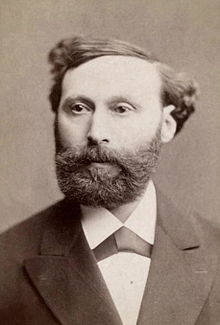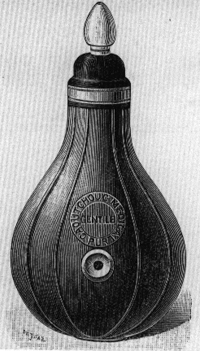Адам Политцер

Адам Политцер ( Венгерский : Адам Политцер ; 1 октября 1835 года, Альбертирса , вредитель , Венгрия - 10 августа 1920 года, в Вене ), был венгерским и австрийским врачом и одним из пионеров и вещей Отологии .
Жизнь
[ редактировать ]Адам Политцер родился в Альберти (ныне часть Альбертирса), недалеко от города Будапешт , в зажиточной еврейской семье.
Он изучал медицину в Университете Вены . Некоторые из его учителей принадлежали ко второй « Венской школе », в том числе Карл Фрайерр фон Рокитанский (1804–1878) и Йозеф Скода (1805–1881) (его основатели), а также Джозеф Хирт (1810–1894), Иоанн Риттер), а также Иосиф Хиртл (1810–1894), Иоанн Риттер), а также Иосиф Хиртл (1810–1894), Иоанн Риттер), а также Иосиф Хиртл (1810–1894), Иоанн Риттер Oppolzer (1808–1871) и физиолог Карл Людвиг (1816–1895). Последние два интересовались Политцером и были влиятельны в его последующей карьере.
Политцер получил степень доктора медицины в 1859 году и начал работать в лаборатории Карла Людвига. Его интересом с тех пор в основном была физика системы слуховой . Там он был первым, кто физиологически продемонстрировал, что иннервация тензорной мышцы бакалавцированной барабаны была из -за тройничного нерва и что иннервация стапедиальной мышцы была лицевой нервом . В другой серии экспериментов Политцер связал два манометра , один из которых помещен во внешний слуховой канал Meatus и другой в глотке , чтобы изучить движения воздуха через евстахискую трубку . В 1861 году он опубликовал свои первые результаты по новой технике, основанной на этих знаниях, для лечения внутренних заболеваний уха путем вторжения среднего уха через евстахийскую трубку, что устраняло необходимость его катетеризации . Это стало известно как политизирование . В последующие десятилетия техника была широко принята во всем мире, принося славу Политцеру.
In the following year, Politzer travelled to other centers and countries, seeking to increase the depth of his practical training. Thus, he worked consecutively with Anton Friedrich Freiherr von Troeltsch (1829–1890) and physiologist Heinrich Müller, in Würzburg; Hermann Helmholtz (1821–1894) in Heidelberg. He also went to Paris, France, to study with Rudolf Körni, Prosper Ménière, the "father of physiology", Claude Bernard (1813–1878) and with physicist Karl Rudolf König (1832–1901). He also studied microscopic anatomy of the labyrinth with Albert von Kölliker (1817–1905) in Würzburg, and ear surgery with Joseph Toynbee (1815–1866) in London, England.
Returning to Vienna in 1861, Politzer became a professor of otology at the University of Vienna with the support of von Oppolzer. Two years later, in 1863, he opened a private otological clinic with Josef Gruber (1827–1900), which soon began to attract patients from all over the world. In 1864 Politzer was allowed by the government to treat indigent patients at the charity hospital as well as in the homes for elderly. He and Gruber received the title of professor extraordinarius in 1870 and were appointed to the rank of a joint directorship to a new clinic in the Vienna General Hospital, in the next year (the first of its kind in the world). In 1895 Politzer won a full professorship and became the sole director of the clinic in 1889, until 1907. He died 13 years later, in 1920, at the age of 85, celebrated as one of the pioneers of modern otology in the history of medicine, but unfortunately in a poor financial condition, due to the economic crisis in Austria after the country was defeated in the First World War.
Works
[edit]Politzer was a prolific inventor of new medical devices for the diagnosis and treatment of ear diseases. He developed several surgical instruments which bear his name for the operation of the outer and the inner ear structures, such as an ear perforator, a surgical knife, a grommet for the ventilation of the middle ear after tympanocentesis, as well as a method to restore permeability to the Eustachian tube by using an insufflator made out of a pear-shaped rubber bag ("politzerisation" or Politzer's method). He also devised methods and apparatuses to examine the outer ear canal and tympanic membrane (Politzer's otoscope), a speculum and a qualitative test for the function of the Eustachian tube. In the field of hearing, Politzer devised an acoumeter for measuring hearing acuity and at least two early acoustical hearing aids.
Furthermore, he revolutionised the clinical diagnosis of aural diseases by the inspection of the illuminated tympanic membrane (which led to the current otoscope), and developed the first illustrated atlas of the tympanic membrane in health and disease, with color drawings made by himself. Politzer also wrote one of the most outstanding and authoritative textbooks on otology of the century, the Lehrbuch der Ohrenheilkunde, in 1878. With von Troeltsch and Hermann Schwartze, he founded Archiv für Ohrenheilkunde, the first journal dedicated to ear disorders.
A great anatomist of the auditory system, Politzer wrote and illustrated extensively on it, and left a remarkable collection of anatomic and pathological specimens in Vienna, which were donated to the Anatomy and Pathology Museum. The luminous cone of the tympanic membrane is named after him, as well as the Unna–Politzer nevus, a typical birthmark found on the nape of the neck in 25 to 50% of normal persons. In addition, in 1893 Politzer was the first to describe otosclerosis as a separate clinical entity. He also studied the pathology of cholesteatoma, serous otitis media, labyrinthitis, congenital deafness and intracranial complications of otitis media.
One of his biographers, Albert Mudry, stated that Politzer was "the greatest otologist of the 19th century and one of the greatest of all time (...) he covered all fields of otology". He influenced and trained thousands of otologists from over the world, and his best-known successor was Robert Bárány, who received the Nobel Prize for medicine in 1914.

Bibliography
[edit]- Die Beleuchtungsbilder des Trommelfells im gesunden und kranken Zustande. Vienna, W. Braumüller, 1865. English translation, New York, 1869.
- Zehn Wandtafeln zur Anatomie des Gehörorgans. Vienna, 1873.
- Lehrbuch der Ohrenheilkunde. Stuttgart, F. Enke, 1878, 1882, 1893, 1902, 1908.
- Die anatomische und histologische Zergliederung des menschlichen Gehörorgans im normalen und kranken Zustande. Vienna, 1889.
- Atlas der Beleuchtungsbilder des Trommelfells. Vienna, 1899.
- Geschichte der Ohrenheilkunde. 2 volumes. Stuttgart, F. Enke, 1907 and 1913.
- Atlas und Grundriss der Ohrenheilkunde. Unter Mitwirkung von A. Politzer herausgegeben von Gustav Brühl. Munich, 1901. Volume 24 of Lehmanns Medizinische Handatlanten.
Внешние ссылки
[ редактировать ]- Адам Политцер . Whonamedit
- Адам Политцер . Entlink
- Мудри, А. Роль Адама Политцера в истории отологии . Являюсь. Дж. Отол. 21: 753–763,2000
- Еврейская энциклопедия : «Политцер, Адам» , Исидор Сингер и Фредерик Ханеман (1906).
- Адам Политцер Общество